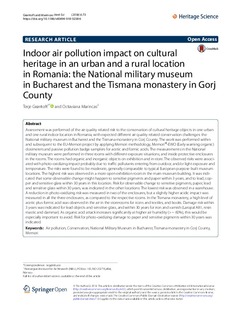| dc.description.abstract | Assessment was performed of the air quality related risk to the conservation of cultural heritage objects in one urban and one rural indoor location in Romania, with expected different air quality related conservation challenges: the National military museum in Bucharest and the Tismana monastery in Gorj County. The work was performed within and subsequent to the EU-Memori project by applying Memori methodology, Memori®-EWO (Early warning organic) dosimeters and passive pollution badge samplers for acetic and formic acids. The measurements in the National military museum were performed in three rooms with different exposure situations, and inside protective enclosures in the rooms. The rooms had organic and inorganic objects on exhibition and in store. The observed risks were associated with photo-oxidizing impact probably due to traffic pollutants entering from outdoor, and/or light exposure and temperature. The risks were found to be moderate, generally comparable to typical European purpose built museum locations. The highest risk was observed in a more open exhibition room in the main museum building. It was indicated that some observable change might happen to sensitive pigments and paper within 3 years, and to lead, copper and sensitive glass within 30 years in this location. Risk for observable change to sensitive pigments, paper, lead and sensitive glass within 30 years, was indicated in the other locations. The lowest risk was observed in a warehouse. A reduction in photo-oxidizing risk was measured in two of the enclosures, but a slightly higher acidic impact was measured in all the three enclosures, as compared to the respective rooms. In the Tismana monastery, a high level of acetic plus formic acid was observed in the air in the storerooms for icons and textiles, and books. Damage risk within 3 years was indicated for lead objects and sensitive glass, and within 30 years for iron and varnish (Laropal A81, resin mastic and dammar). As organic acid attack increases significantly at higher air humidity (> ~ 60%), this would be especially important to avoid. Risk for photo-oxidizing damage to paper and sensitive pigments within 30 years was indicated. | nb_NO |

